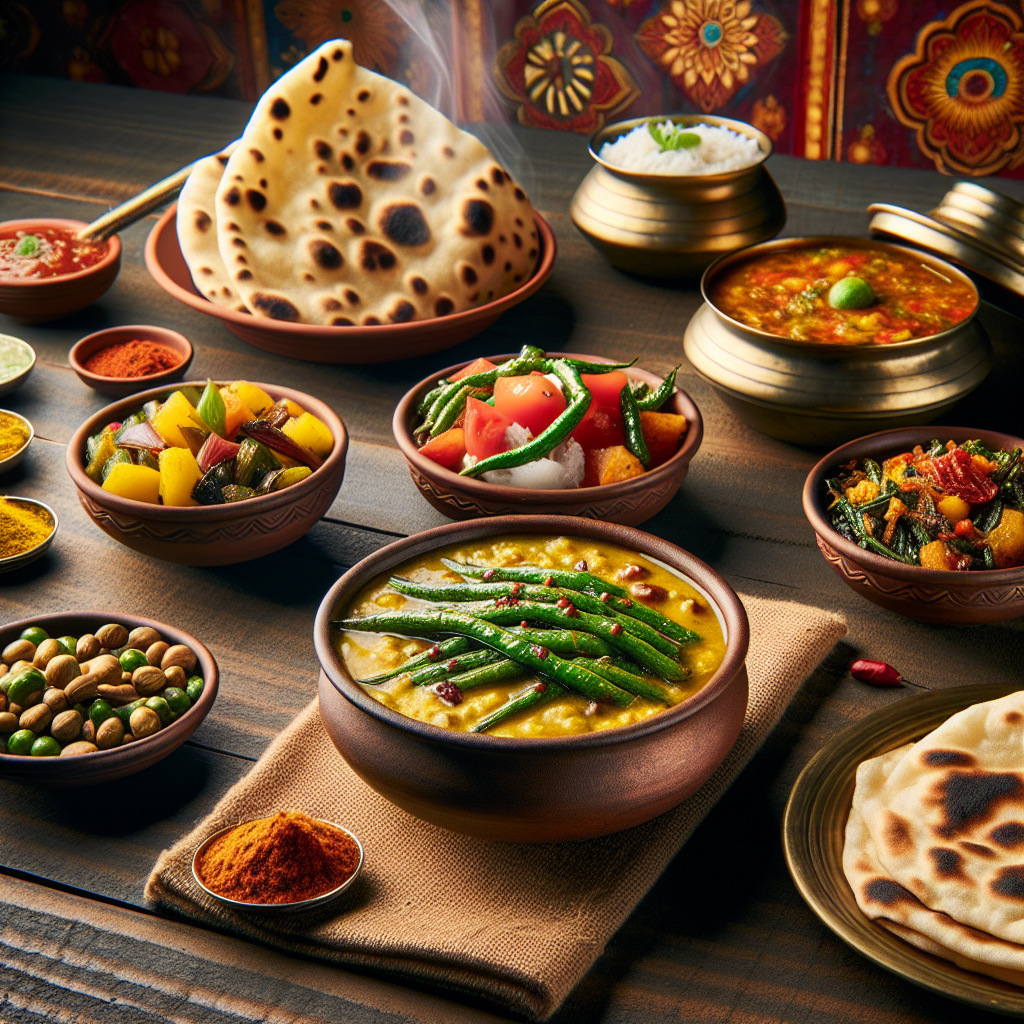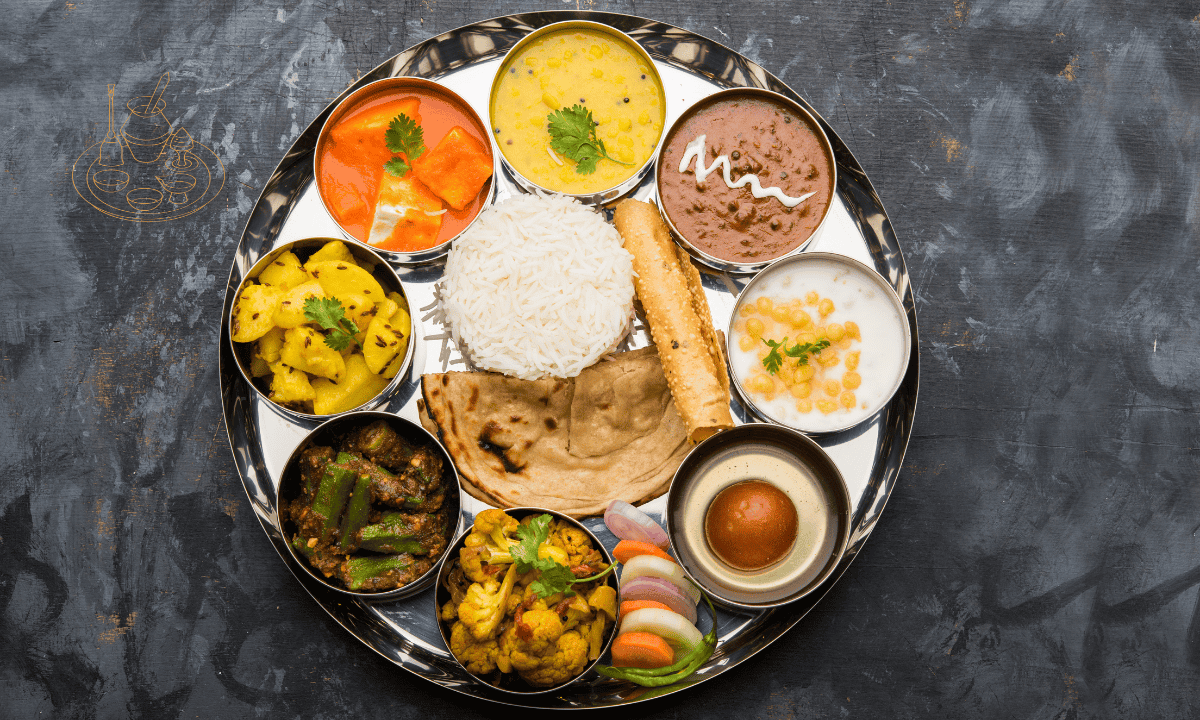A simple Indian thali is a feast for the senses, offering a delightful array of flavors, textures, and aromas on a single plate. This traditional way of serving meals in India has been cherished for centuries, providing a balanced and satisfying dining experience. In this article, we’ll explore the world of simple Indian thali, its components, variations, and how you can create your own at home.
Table of contents

The Components of a Simple Indian Thali
A typical simple Indian thali consists of several elements, each playing a crucial role in creating a well-rounded meal:
- Main dish: Usually a curry or dal (lentil soup)
- Rice or flatbread: Steamed rice or various types of Indian bread like roti or naan
- Side dishes: Vegetable preparations, yogurt (raita), and pickles
- Dessert: A sweet treat to end the meal on a high note
The beauty of a simple Indian thali lies in its versatility. You can easily customize it to suit your preferences or dietary requirements, making it an ideal choice for both vegetarians and non-vegetarians alike.
Related 7 Days Healthy Breakfast Indian: Nutritious Recipes to Kick-Start Your Mornings.
Popular Simple Indian Thali Variations
North Indian Thali
A North Indian thali often includes:
- Dal makhani (creamy lentil curry)
- Paneer tikka masala (cottage cheese in spiced tomato gravy)
- Jeera rice (cumin-flavored rice)
- Naan or roti
- Raita (yogurt with cucumber and spices)
- Gajar ka halwa (carrot pudding) for dessert
South Indian Thali
A South Indian thali might feature:
- Sambar (lentil and vegetable stew)
- Rasam (tangy soup)
- Vegetable poriyal (dry vegetable preparation)
- Steamed rice
- Papadum (crispy lentil wafer)
- Payasam (sweet milk pudding) for dessert
Simple Indian Veg Thali
A simple Indian veg thali could include:
- Chana masala (spiced chickpea curry)
- Aloo gobi (potato and cauliflower curry)
- Jeera rice
- Roti
- Mixed vegetable raita
- Kheer (rice pudding) for dessert
How to Prepare a Simple Indian Thali at Home
Creating a simple Indian thali at home might seem daunting, but with some planning and easy recipes, it’s quite achievable. Here’s how to go about it:
- Plan your thali: Decide on a main dish, a type of bread or rice, 2-3 side dishes, and a dessert.
- Prep ingredients in advance: Chop vegetables, measure spices, and soak lentils the night before.
- Cook in order of complexity: Start with dishes that take longer to cook, like dal or rice.
- Use shortcuts: Incorporate pre-made pickles or quick-cooking flatbreads like chapati.
Quick recipe ideas:
- Dal tadka: Yellow lentils tempered with cumin and garlic
- Jeera rice: Basmati rice flavored with cumin seeds
- Aloo matar: Simple potato and pea curry
- Cucumber raita: Grated cucumber in yogurt with a pinch of cumin
Remember, the key to a successful simple Indian thali is balance. Aim for a mix of flavors (spicy, tangy, sweet) and textures (crispy, soft, creamy) in your meal.
The Cultural Significance of Thali
The thali isn’t just a meal; it’s a representation of Indian dietary principles. It embodies the concept of a balanced diet, ensuring that diners receive a variety of nutrients in a single sitting. The arrangement of dishes on the thali also follows a particular order, with each item meant to be eaten in a specific sequence to aid digestion.
Regional variations in thalis reflect the diverse culinary traditions across India. From the ghee-rich Rajasthani thali to the coconut-infused Keralite sadya, each region’s thali tells a story of its climate, agriculture, and cultural history.
Simple Indian Thali for Different Meals
Lunch Simple Indian Thali Ideas
For a light yet satisfying lunch thali, consider:
- Dal fry (yellow lentil curry)
- Steamed rice
- Bhindi masala (spiced okra)
- Cucumber raita
- Roti
- Fresh fruit for dessert
Simple Indian Food for Dinner Options
For dinner, you might prefer a slightly heartier thali:
- Paneer butter masala (cottage cheese in rich tomato gravy)
- Jeera rice
- Mixed vegetable curry
- Naan bread
- Boondi raita (yogurt with fried gram flour balls)
- Gulab jamun (milk-solid dumplings in sugar syrup) for dessert
Conclusion
The simple Indian thali is a testament to the rich culinary heritage of India. It offers a complete meal that’s not only delicious but also nutritionally balanced. Whether you’re enjoying a elaborate feast or a quick weekday dinner, the thali format allows for endless possibilities to explore the diverse flavors of Indian cuisine.
We encourage you to try creating your own simple Indian thali at home. Start with a few basic elements and gradually expand your repertoire. Remember, the beauty of a thali lies in its adaptability – feel free to mix and match dishes according to your taste preferences and what’s available in your kitchen. Happy cooking and bon appétit, or as they say in Hindi, “Khaane ka maza lijiye!”
Frequently Asked Questions
An Indian thali typically includes:
1. Main dish: A curry or dal (lentil dish)
2. Carbohydrates: Rice and/or flatbread (like roti or naan)
3. Side dishes: 2-3 vegetable preparations
4. Accompaniments: Yogurt (raita), pickle, papadum (crispy lentil wafer)
5. Dessert: A sweet dish to complete the meal
The exact components can vary based on region, season, and personal preferences. A thali might have fewer items, while a more elaborate one could include additional dishes.
The Indian thali meal plan is a balanced approach to dining that incorporates all major food groups in a single meal. It typically follows this structure:
1. Start with a small portion of something bitter or tangy to stimulate appetite
2. Move on to the main savory dishes, alternating between bites of curry, vegetables, rice, and bread
3. Cleanse the palate with yogurt or raita
4. End with a sweet dish
This plan ensures a variety of flavors and nutrients in each meal, promoting both satisfaction and good health. The thali meal plan can be adapted for different dietary needs, including vegetarian and vegan options.
Several regional thalis are famous across India, each reflecting local culinary traditions:
1. Gujarati Thali: Known for its sweet, salty, and spicy flavors, often vegetarian
2. Rajasthani Thali: Famous for its rich, ghee-laden dishes and variety of breads
3. Bengali Thali: Celebrated for its fish preparations and sweet dishes
4. South Indian Thali: Popular for its rice-based dishes, sambars, and rasams
5. Maharashtrian Thali: Loved for its balance of vegetarian and non-vegetarian options
6. Punjabi Thali: Famous for its hearty, flavorful dishes and variety of breads
Each of these thalis offers a unique taste experience, showcasing the diversity of Indian cuisine.
एक भारतीय थाली में आमतौर पर निम्नलिखित व्यंजन शामिल होते हैं:
1. मुख्य व्यंजन: एक करी या दाल
2. अनाज: चावल और/या रोटी (जैसे चपाती या नान)
3. साइड डिश: 2-3 सब्जी के व्यंजन
4. साथ में: दही (रायता), अचार, पापड़
5. मिठाई: भोजन को पूरा करने के लिए एक मीठा व्यंजन
थाली में शामिल व्यंजनों की सटीक संख्या और प्रकार क्षेत्र, मौसम और व्यक्तिगत पसंद के आधार पर भिन्न हो सकते हैं। एक साधारण भारतीय थाली में कम व्यंजन हो सकते हैं, जबकि एक अधिक विस्तृत थाली में अतिरिक्त व्यंजन शामिल हो सकते हैं। थाली का मुख्य उद्देश्य एक संतुलित और पौष्टिक भोजन प्रदान करना है जो सभी स्वादों और पोषक तत्वों को शामिल करता है।
